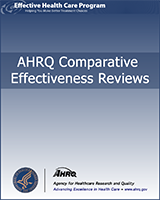NCBI Bookshelf. A service of the National Library of Medicine, National Institutes of Health.
Coleman CI, Baker WL, Kluger J, et al. Comparative Effectiveness of Angiotensin Converting Enzyme Inhibitors or Angiotensin II Receptor Blockers Added to Standard Medical Therapy for Treating Stable Ischemic Heart Disease [Internet]. Rockville (MD): Agency for Healthcare Research and Quality (US); 2009 Oct. (Comparative Effectiveness Reviews, No. 18.)
This publication is provided for historical reference only and the information may be out of date.

Comparative Effectiveness of Angiotensin Converting Enzyme Inhibitors or Angiotensin II Receptor Blockers Added to Standard Medical Therapy for Treating Stable Ischemic Heart Disease [Internet].
Show detailsA succinct summary of evidence on comparative long-term benefits and harms of ACE inhibitors and/or ARBs in patients with preserved left ventricular function who have stable ischemic heart disease or heart disease risk equivalents is presented in Table 15. More elaborate discussions are provided at the end of the results for each Key Question. More detailed assessments of strength of evidence for major clinical outcomes and harms are summarized in a EPC grading table of evidence (Appendix Tables 41–47). Major clinical outcomes are those explicitly stated in Key Questions 1–3 and 7 and harms in Key Questions 4–6. Members of the TEP identified these outcomes as important because they are most relevant to patients, clinicians, and policymakers; and have adequate data from studies meeting eligibility criteria for the comparative effectiveness review. Clinical outcomes included total mortality, cardiovascular mortality, nonfatal myocardial infarction, stroke, a composite of cardiovascular mortality, nonfatal myocardial infarction and stroke, atrial fibrillation, symptom reporting, total hospitalizations, hospitalization for angina, hospitalization for heart failure, revascularization and quality of life. Harms included withdrawals due to adverse events, hypotension, syncope, cough, angioedema, hyperkalemia, rash, and blood dyscrasias.
Table 15
Outcomes, strength of evidence, and conclusions.
- Summary and Discussion - Comparative Effectiveness of Angiotensin Converting Enz...Summary and Discussion - Comparative Effectiveness of Angiotensin Converting Enzyme Inhibitors or Angiotensin II Receptor Blockers Added to Standard Medical Therapy for Treating Stable Ischemic Heart Disease
Your browsing activity is empty.
Activity recording is turned off.
See more...